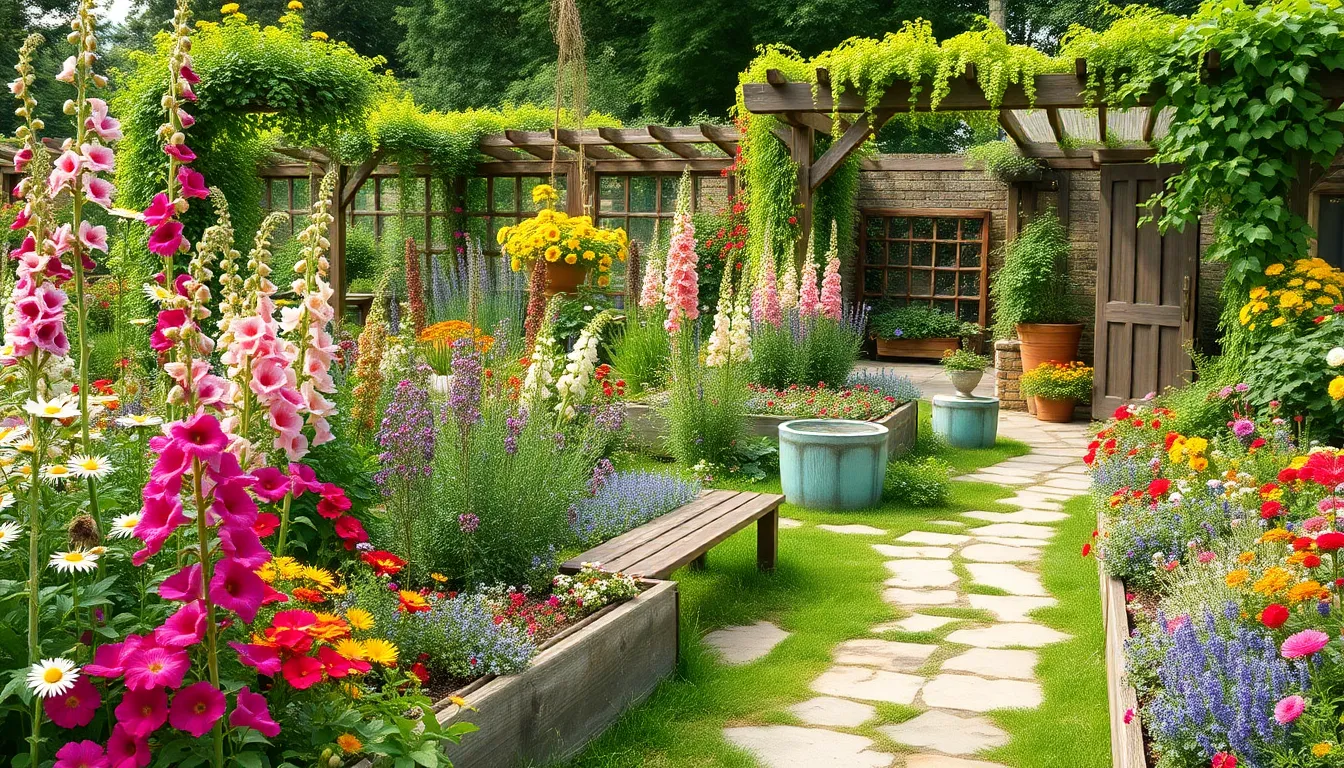Picture this: a whimsical retreat bursting with colorful blooms, charming pathways, and the sweet scent of lavender wafting through the air. That’s the magic of cottage garden design. It’s not just a garden; it’s a delightful escape that invites nature in and makes even the busiest bee stop for a selfie.
Cottage Garden Design
Cottage garden design embodies a blend of aesthetics and functionality. This gardening style prioritizes colorful flowers and diverse plant species, creating a lively atmosphere. Within these gardens, natural materials such as stone, wood, and brick often form charming pathways that invite exploration.
Plants in cottage gardens are typically arranged in a seemingly random, yet intentional manner. Heirloom flowers and perennial plants thrive, adding to the visual appeal. Herbs and vegetables frequently coexist with ornamental plants, supporting both beauty and utility.
Incorporating features such as benches fosters relaxation and makes spaces more inviting. Additionally, climbing plants may adorn trellises, enhancing vertical interest. Seasonal blooms ensure ongoing interest, as different plants flower throughout the year.
Wildlife plays a significant role in cottage gardens, attracting pollinators like bees and butterflies. By including native plants, gardeners encourage biodiversity and promote ecological balance. Emphasizing low-maintenance options can simplify upkeep while preserving the garden’s charm.
Weather-resistant containers add versatility, allowing for creative arrangements. These containers accommodate a variety of planting options, contributing to year-round interest. Incorporating personal touches, such as unique ornaments or sculptures, enhances the garden’s character.
Overall, cottage garden design combines a relaxed aesthetic with practicality. This style fosters an enchanting environment that draws both people and wildlife, creating a picturesque retreat. With thoughtful planning, it’s possible to cultivate a garden that reflects individuality while celebrating nature’s beauty.
Key Elements of Cottage Gardens

Cottage gardens thrive on a harmonious blend of creativity and practicality. Certain elements define their enchanting appeal.
Plant Selection
Diverse plants create vibrant displays in cottage gardens. Perennial flowers, such as daisies and hollyhocks, provide consistent blooms year after year. Heirloom varieties like sweet peas and antique roses enhance charm with their historical significance. Vegetables and herbs, including tomatoes and basil, contribute functionality to the aesthetic. Native species attract pollinators, playing a crucial role in supporting local ecosystems. Leaving some areas slightly overgrown adds to the garden’s natural feel, allowing self-seeding plants to flourish.
Garden Structure
Structures define the visual flow and organization of cottage gardens. Pathways made from natural stone direct visitors through the garden’s intricate layout. Wooden arbors and trellises increase vertical interest while supporting climbing plants. Raised beds not only enhance accessibility but also create defined spaces for both flowers and edibles. Benches provide inviting resting spots, encouraging visitors to appreciate the surroundings. Incorporating arches or fences adds character and frames key views within the landscape. Each structural element complements the overall aesthetic while ensuring a cozy, welcoming environment.
Design Principles for Cottage Gardens
Cottage gardens thrive on principles that focus on creativity, beauty, and practicality, blending various elements to create alluring spaces. Key aspects include harmonious color schemes and effective planting techniques.
Color Schemes
Bright color palettes define cottage gardens, attracting the eye with lively arrangements. Seasonal blooms incorporate warm shades like reds, oranges, and yellows, contrasted by cooler tones of blues and purples. Plant combinations elicit an organic feel, resulting in a dynamic visual experience throughout the year. Soft pastels contribute serenity while vibrant hues add energy, inviting exploration. Selecting complementary colors enhances unity and flow, creating a picturesque setting that feels alive and welcoming.
Planting Techniques
Planting techniques in cottage gardens emphasize both abundance and diversity. Clumping plants results in lush arrangements, imitating nature’s wild aesthetic. Layered heights build visual interest, with taller plants positioned at the back and shorter varieties in the front. Mixing perennials, annuals, and edibles maximizes utility while ensuring continuous blooms. Wildlife-friendly selections attract pollinators, boosting biodiversity within garden ecosystems. Companion planting strategies bolster growth and repel pests, contributing to overall resilience and health.
Maintenance Tips for Cottage Gardens
Maintaining a cottage garden involves regular attention and care to keep plants healthy and vibrant.
Seasonal Care
Seasonal care plays a crucial role in cottage garden maintenance. In spring, planting and soil enhancement ensure a strong foundation for blooms. Summer months require regular watering to support thirsty plants, while deadheading promotes continued flowering. Fall involves mulching and preparing plants for winter, protecting roots from cold temperatures. During winter, assessing damage and planning spring planting can set the stage for a thriving garden return. Adapting strategies with each season keeps your garden lush and inviting.
Pest Control
Effective pest control is vital for maintaining a healthy cottage garden. Natural predators like ladybugs and lacewings can reduce pest populations. Monitoring plants regularly for signs of damage or infestation aids early intervention. Organic options such as neem oil or insecticidal soap provide safe alternatives to harsh chemicals. Creating a diverse plant environment attracts beneficial insects that deter pests. A proactive approach ensures the beauty and health of a cottage garden endure throughout the growing season.
Conclusion
Cottage garden design offers a unique blend of beauty and functionality that transforms any outdoor space into a vibrant haven. By incorporating diverse plant selections and natural materials, these gardens create inviting pathways and cozy retreats. The emphasis on attracting wildlife not only enhances the garden’s charm but also supports local ecosystems.
With a focus on creativity and practicality, cottage gardens reflect individuality while celebrating nature’s splendor. Regular maintenance ensures the garden remains a flourishing sanctuary throughout the seasons. Embracing the principles of cottage garden design can lead to a delightful and enchanting environment that brings joy to both gardeners and visitors alike.

